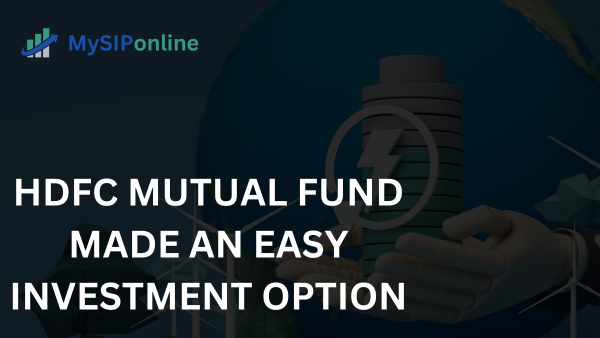HDFC Mutual Fund provides a straightforward and accessible way for individuals to invest their money and potentially grow their wealth over time.
With HDFC Fund House, investors have the opportunity to benefit from the expertise of seasoned professionals like Mr. Munot, who brings decades of experience in financial markets.
Through careful management and strategic planning, HDFC’s asset management company aims to help investors navigate the complexities of the investment landscape while minimizing risks and maximizing returns.
By offering a diverse range of investment options and ensuring transparency in operations, HDFC asset management company empowers investors to make informed decisions and work towards their financial goals with confidence.
What are the Advantages of HDFC Mutual Fund?
The advantages of HDFC Mutual schemes are –
Expert Management
Experienced specialists oversee HDFC mutual schemes, making well-informed investment choices on investor’s behalf
Diversification
By distributing an investor’s capital throughout a number of assets, investing in HDFC mutual schemes lowers the risk of loss that comes with concentrating assets in a single security or asset class.
Accessibility
To meet the various demands of investors, HDFC mutual fund provide simple access to a large of investment possibilities, including debt, hybrid securities, and stocks.
Transparency
To enable investors to make well-informed decisions, HDFC asset management company regularly updates and publishes fund performance, holdings, and expenditures.
Affordability
HDFC AMC is accessible to a broad spectrum of investors due to its lower investment minimums than other investing alternatives.
Tax Efficiency
Tax-saving mutual funds (ELSS), which allow deductions under Section 80C of the Income Tax Act, are one of the tax-benefiting HDFC asset management programs.
Potential for Returns
Although historical performance does not guarantee future outcomes, investors can reach their financial objectives by investing in HDFC MF, which has the potential to yield strong long-term returns.
Which HDFC Mutual Fund is best for SIP?
- HDFC Small Cap Fund
- HDFC Large & Mid Cap Fund
- HDFC Flexi Cap Fund
- HDFC Balanced Advantage Fund
- HDFC Multi-Asset Fund
Who is the CEO of HDFC Mutual Fund?
Mr. Munot boasts an impressive track record spanning more than 30 years in the dynamic realm of financial markets. His long career includes a number of noteworthy positions that have added to his thorough comprehension of financial dynamics.
Before joining HDFC AMC, he held important roles at renowned organizations, each of which added a special flavour to his experience. He developed his talents in strategic investment management while working as Chief Investment Officer at SBI Mutual Fund
His work as an Executive Director and Head of a Multi-Strategy Boutique at Morgan Stanley Investment Management expanded his understanding by exposing him to a wide range of investment strategies and the complex workings of the market.
Furthermore, his position as Chief Investment Officer of Birla Sun Life mutual funds fixed income and hybrid funds cemented his proficiency in managing diverse asset classes. Because of his extensive, Mr Munot is regarded as a seasoned professional who can guide HDFC’s clients toward the best investment plans.
Types of Risks Managed by HDFC Mutual Fund
There are many risks to handle by HDFC AMC
Market Risk
HDFC asset management fund house manages market risk, which refers to the potential losses arising from changes in the market prices of securities. This risk can stem from factors such as economic conditions, interest rates, and geopolitical events. To mitigate market risk, HDFC MF employs diversification strategies across various asset classes and sectors.
Credit Risk
Credit risk is managed by HDFC asset management company, which pertains to the possibility of loss arising from a borrower’s failure to repay a debt obligation. HDFC MF assesses the creditworthiness of issuers and counterparties to minimize the impact of credit defaults. Additionally, diversification across different credit qualities and rigorous credit analysis are employed to manage this risk.
Inflation Risk
HDFC Mutual schemes address inflation risk, which refers to the potential erosion of purchasing power due to rising prices over time. To mitigate inflation risk, HDFC MF invests in assets that have the potential to provide returns that outpace inflation, such as equities and real assets.
Interest Rate Risk
Interest rate risk is managed by HDFC AMC, which arises from fluctuations in interest rates impacting the value of fixed-income securities. HDFC MF employs duration management techniques and diversification across maturities to mitigate interest rate risk in its bond portfolios.
Liquidity Risk
HDFC asset management comapny manages liquidity risk, which relates to the inability to buy or sell investments quickly without significantly impacting their prices. HDFC MF maintains a balanced portfolio with sufficient liquidity and monitors market conditions to ensure effective liquidity management.
Currency Risk
Currency risk is managed by HDFC Mutual Fund, which arises from fluctuations in foreign exchange rates impacting investments denominated in foreign currencies. HDFC MF may hedge currency exposure or invest in domestic securities to mitigate currency risk in international investments.
Business and Industry Risk
HDFC asset management company addresses business and industry risk, which refers to the potential impact of adverse events specific to a particular business or industry sector. HDFC MF diversifies across industries and conducts thorough research to mitigate the impact of business and industry-specific risks.
Political and Regulatory Risk
Political and regulatory risk is managed by HDFC Mutual schemes, which arises from changes in government policies, regulations, or geopolitical events impacting investments. HDFC MF monitors political developments and regulatory changes to adjust investment strategies accordingly and minimize potential risks.
Event Risk
HDFC asset management company manages event risk, which refers to the potential impact of unforeseen events such as natural disasters, corporate scandals, or geopolitical crises on investments. HDFC MF conducts scenario analysis and stress testing to assess the potential impact of such events and adjusts portfolio holdings as needed to mitigate event risk.
Concentration Risk
HDFC Mutual schemes address concentration risk, which arises from having a significant portion of investments concentrated in a single asset, sector, or issuer. HDFC MF diversifies its portfolio across different asset classes, sectors, and securities to minimize concentration risk and spread exposure.
To summarize, HDFC asset management company successfully manages a wide variety of risks through strategic diversification, thorough research, and proactive risk mitigation techniques, guaranteeing strong protection and the potential for long-term gains for investors.
Conclusion
HDFC asset management company provides several benefits to investors. Ranging from skilled management and diversification to accessibility, transparency, and tax efficiency.
HDFC Mutual schemes also efficiently handle a variety of risks, such as market risk, credit risk, inflation risk, interest rate risk, liquidity risk, currency risk, company and industry risk, political and regulatory risk, event risk, and concentration risk.
Investors can increase their wealth growth while limiting the impact of market volatility by using Systematic Investment Plan (SIPs).
Overall, HDFC Asset Management Company is a trusted partner for investors looking to attain their financial objectives with confidence and efficiency.



